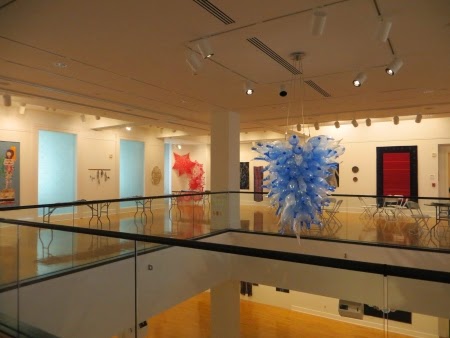The California Fibers exhibit at Soka University in Aliso Viejo is nearing the end of its stay...through May 8. If you haven't been, it's definitely worth a trip. The gallery is in a gorgeous setting on the campus and is a wonderful space to view art.
I recently was finally able to go up and see the show and brought back some more photos of pieces not previously highlighted, plus detail shots that may persuade you to visit...because fiber in real life is very different than it is in photos.
There are two floors of hanging art, with plenty of open space to view the work.
On this trip, I focused on documenting details of some of the work, as well as some pieces that haven't been on our blog or Facebook page.
This is a detail of Lynne Hodgman's
Altarpiece...
Next is Michael Rohde's Transect and Chari Myers' Neighborhood, with Peggy Wiedemann's Off the Wall on the opposite wall.
Here is Myers' piece close up.
Marilyn McKenzie Chaffee's pieces Marking Time #4: Contemplating a Forty Year Milestone and Marking Time #5: Celebrating a Forty Year Milestone hung together (#5 is on top)...
Interestingly, the glass panels on either side of her pieces echo the Xs...
Which we spent quite a bit of time trying to figure out, construction-wise. They are fascinating pieces close up.
Next to them is Lori Zimmerman's intriguing series
Mending 1.1, 1.2, and
1.3...
Doshi's hand-dyed pieces are a treat to see in person...this is
Bamboo...
with a closeup photo of the details in the silk...
This is also Doshi's,
Golden Sunset.
This is a detail of the bottom of the kimono, so you can see the bits of silk organza, which look like ashes or leaves floating in the sunset sky.
Susan Hart Henegar's
Triptych of tapestries were stunning.
And this is Cameron Taylor-Brown's
Indigo Dreams #1, which caught our attention for quite a while, as we tried to figure out what was ikat and what was paint and how it all came together.
Gail Fraser's
Impulse also intrigued us...
Part pod, resembling a canoe, but reminding me (the science teacher) of a nerve cell with ganglia on either side...
Resting inside, more pods...
Carrie Burckle's piece
Rend 1 reminded us of skin, torn and patched and wrinkled...
especially when you see it as a whole...this is a fascinating piece.
This is Kathy Nida's
Untied...is she falling to Earth or rising above it?
Another of Carrie Burckle's pieces, this is
Healing Field 1...
with a closeup of the stitching...
Around the corner is Lydia Tjioe-Hall's intriguing
Mother and Child, built on metal electrical hardware...they seem to be speaking to each other...
Here is one of Julie Kornblum's recycled art pieces,
Plastic in the Trees 2, made of surplus yarn and plastic bags.
Charlotte Bird's
Small Wonders is at the entrance to the exhibit, and pulls everyone in to the room...
Here are some detailed shots of her tiny living creatures...
Under the microscope...
The detail in the tiny pieces and the embroidery could engage you for quite a long time...
Polly Jacobs Giacchina's piece
Specimens is another collection of intriguing items...
The attention to detail and use of the wire with natural materials asks you to stay longer...
and is also reminiscent of biological beasts under the microscope or things found in your fishnet at the end of the day.
Carrie Burckle's two hanging pieces
Bruised and Empty Purple and
Bruised and Empty Pink have to be seen in person to be fully appreciated...
The detail of the dye process and the stitching are subtle (with Susan Henry's
Vortex in the background).
Susan Hart Henegar's piece
Still the Voices hangs near Carol E. Lang's pieces...
On top is Lang's
Tribute in Black; below is
Tribal Tribute XIII...
We were (again) fascinated with Lydia Tjioe-Hall's piece
Time Warp...
No matter from where you view it...
it grabs your attention.
This is Gail Fraser's
Sojourn II...
A mail cabinet with photos illuminated in the back of each section, small canoes throughout...
Definitely requiring some time to experience...
Near there is Peggy Wiedemann's
Hanging Out...
And a detail looking up to the top, showing the intricate stitching and wrapping in this piece...
This is a detail of Polly Jacobs-Giacchina's piece
Textures Strung Out...
This is another of Doshi's pieces,
Illusion Waltz...
with a detail of the discharged fabrics...
Julie Kornblum's
Plastic in the Trees 1 hangs nearby.
Looking down the wall, you can see Michael Rohde's
Pastorale and Julie Kornblum's
The Fifth Element...
This is an overview of the upstairs, with a Chihuly glass sculpture hanging in the center.
This is a detail of Charlotte Bird's
Nebula showing the layers of organza and sparkly bits...
That make up this stunning piece.
This is not everything in the show, by far, and the venue is a wonderful place to experience the art. The gallery is open from 9-5 Monday through Friday, and it is free to the public. With only three and half weeks left, you should put it on your calendar.






























































